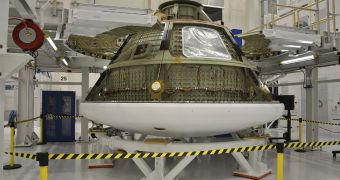The Operations and Checkout (O&C) building at the NASA Kennedy Space Center (KSC), in Florida, is now ready to support the assembly of the first Orion Multi-Purpose Crew Vehicle (MPCV). The capsule is scheduled to carry out its maiden flight in about two years.
Orion will be capable of exploring deeper into space than the Apollo-era capsules were. NASA plans to use it to explore near-Earth asteroids by 2025, and the Red Planet by 2030, as specified by US President Barack Obama's 2010 space policy.
As an interesting note, the new capsule will be assembled and processed in the same KSC facility that handled the Apollo capsules, more than four decades ago. The first MPCV components will reach the O&C building this June, Space reports.
The installation was renovated and modified extensively by main capsule contractor, Lockheed Martin Space Systems, under a $55 million contract with NASA. At this point, the building only contains a test version of the Orion, which is being used to calibrate all machinery that will handle the real capsule.
Most of the new equipment is on wheels or air bearings. Lockheed engineers say that this makes it very easy to reconfigure the inside of the O&C installation in any way they see fit during the assembly process. These reconversions can be done very quickly.
“Building the [Orion] here has never been done before, so this is kind of a first. There's been a lot of integration in this building, Apollo was integrated here, [but] it didn't look anything like this. We made extensive modifications to the facility,” explains Jim Kemp.
The Lockheed Martin official holds an appointment as the director for Orion assembly, testing and launch operations. “A lot of the things we did to the facility was to make it more flexible,” he says.
“I think if you go into most of the facilities on [the KSC] campus, you'll see a lot of structures bolted to the ground. Anywhere you are bolting something to the floor, you are creating a unique place that can't be used for anything else. You've created a monument. So we designed this thing with no monuments,” he adds.
Oddly enough, he concludes, this type of facility is significantly cheaper to build than a standard one.

 14 DAY TRIAL //
14 DAY TRIAL //